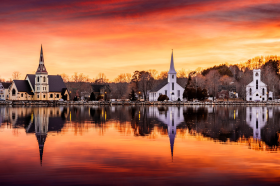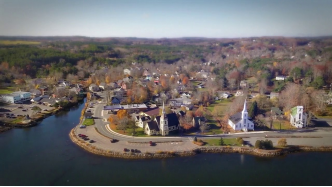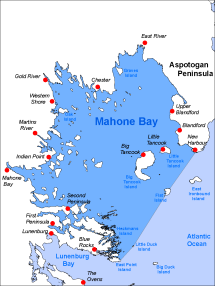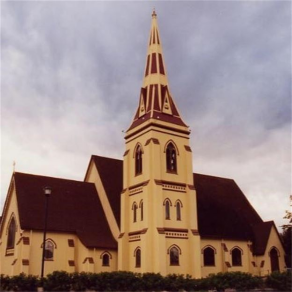Mahone Bay, Nova Scotia 作者: 来源: 发布时间:2021-12-07
I.Population and Area
-Area
Land: 3.12 km2 (1.20 sq mi)
-Population (2016)
Total: 1,036
Density: 332.1/km2 (860/sq mi)

II.Natural Geography (environment and resources)

-Mahone Bay is a town on the northwest shore of Mahone Bay along the South Shore of Nova Scotia in Lunenburg County. A long standing picturesque tourism destination, the town has recently enjoyed a growing reputation as a haven for entrepreneurs and business startups. The town has the fastest growing population of any municipality in Nova Scotia according to the 2016 census, experiencing 9.9% population growth.

III.ECONOMY
-In Mahone Bay, NS, the median household income is $53,035 per year.

-Website: https://www12.statcan.gc.ca/census-recensement/2016/dp-pd/prof/details/page.cfm?Lang=E&Geo1=CSD&Code1=1206008&Geo2=PR&Code2=12&SearchText=Mahone%20Bay&SearchType=Begins&SearchPR=01&B1=All&GeoLevel=PR&GeoCode=1206008&TABID=1&type=0
IV.Industrial Characteristics
-The town is also known for a history of wooden boat building, it was the main industry of Mahone Bay in its earlier years. The Mahone Bay Museum explains and shows this history in detail. Until recent years the town's shipbuilding and boat-building heritage was celebrated by the "Mahone Bay Wooden Boat Festival".
-The view across the harbour is of three prominent churches: St James' Anglican; St John's Evangelical Lutheran; and Trinity United. It has become an iconic image of Nova Scotia, frequently photographed and featured on postcards and calendars. The town has a number of upscale shops and restaurants which almost universally are designed to appeal to the tourist trade, and sometimes shut down during the winter months. The town also has a plastics factory.
V.Attractions
1.Mahone Bay Museum

-The Mahone Bay Museum is a small community museum created by the registered charity, the Mahone Bay Founders Society, that strives to protect and provide (on-site and on-line) access to the history of Mahone Bay area to prevent it from becoming forgotten or lost.
-The Mahone Bay Museum preserves and interprets various artifacts relating to Mahone Bay and area’s history. We are currently working on providing access to pictures of artifacts in our collection. This sneak peek of the artifacts from our collection storage is under construction. Check back soon for more updates.
-The Mahone Bay Museum has an archival collection with documents and photographs related to Mahone Bay. Click here to view a selection of photos from our archives. Public access to these archives is available upon request. Please contact us if you would like to see a list of our archival holdings at 902-624-6263 or by email at info@mahonebaymuseum.com
-The Mahone Bay Museum also houses the Inglis/Quinlan collection, which is on loan to us from the Nova Scotia Museum. Percy Wellington Inglis was a ceramics collector who lived in Mahone Bay. His collection was passed on to his niece, Clara Quinlan, before it was acquired by the Nova Scotia Museum in 1986.
-Address: 578 Main Street PO Box 583
-Phone: 902.624.6263
-e-mail: info@mahonebaymuseum.com
-Website: https://mahonebaymuseum.com/
2.St. James' Anglican Church

-We are situated in the beautiful village of Mahone Bay, in Lunenburg County on the south shore of Nova Scotia. Our parish also includes Christ Church in nearby Maitland.
-We are a friendly congregation and welcome visitors. Please drop in when you're in the area and if you live here, consider joining our worship community.
-Office: 902-624-8614
- Administrator: Barb Zwicker
- Address: 14 Parish St., P.O. Box 25, Mahone Bay NS, B0J 2E05
-Website: https://stjamesmb.vpweb.ca/
3.Kaulback Island
-A picturesque private island located close to Chester, Nova Scotia’s famous seaside town. Kaulbach Island lies perfectly positioned in the heart of Mahone Bay, protected from the elements by an array of tiny islets, surrounded by crystal clear water and close by to both a sailing club and a golf range. Kaulbach Island is just a short boat ride from the mainland, on Nova Scotia's Bluenose Coast. Home to world-class sailing conditions, and close to a hub of activity, within a matter of minutes, you could enjoy the scenic seascapes of Chester or the quaint atmosphere of Mahone Bay, taking in creative festivals, artisans and boutiques along the way. Furthermore, the island is only 90 minutes away from Halifax International Airport, allowing for easy access. The island is more than just a great location however. Osprey Nest, the exceptionally developed 11,040 sq. ft. main house, has a commanding presence overlooking the ocean and the groomed lawns. Framed by colourful gardens and stonewalls, this wonderful home (11 bedrooms, 7 full, 2 half baths) has been thoughtfully designed for gracious family living. Meticulously constructed and maintained, the home warmly welcomes guests for entertaining. Modern and environmentally-friendly, the technology in place at this imposing villa includes effluent disposal and aqua-thermal heat production.
-With 57 acres of woods, meadows, an 11,040 sq. ft. home, double garage with guest quarters, beach cottage, farmhouse, a few outbuildings and a wharf with deep anchorage, Kaulbach Island is home to everything you could possibly need, including a motorboat and a sailboat. Approx 50% of the area of the island has been newly planted with deciduous trees, a small sandy beach can be found on the south side and spectacular views of the maritime environment can be enjoyed from the island’s approx. 35 metre high elevation – there aren’t many views that can rival this!
VI.History
-The end of glaciation began 13,500 years ago and ended with the region becoming largely ice free 11,000 years ago. The earliest evidence of Palaeo-Indian settlement in the region follows rapidly after deglaciation.
-Several thousand years ago the territory of the province became known a part of the territory of the Mi'kmaq nation of Mi'kma'ki. Mi'kma'ki includes what is now the Maritimes, parts of Maine, Newfoundland and the Gaspé Peninsula. The Mi'kmaq lived in an annual cycle of seasonal movement between living in dispersed interior winter camps and larger coastal communities during the summer, including many cites up and down the south shore of Nova Scotia. The town of Mahone Bay is in the traditional Mi'kmaw district of Sipekni'katik.
-In 1605, French colonists established the first permanent European settlement in the future Canada (and the first north of Florida) at Port Royal, founding what would become known as Acadia. The survival of the Acadian settlements was based on successful cooperation with the region's Indigenous peoples. While an attempt was briefly made to found a French colony at LaHave, the effort failed and few significant Acadian communities of more a few families existed on the Atlantic coast of Nova Scotia during British expansion into the area.
-Upon the outbreak of Father Le Loutre's War, on October 5, 1749, Governor Edward Cornwallis sent Commander White with troops in the 20-gun sloop Sphinx to the Acadian town of Mirligueche and had the village destroyed. In 1753, three years into Father Le Loutre's War, John Creighton and Jean-Baptiste Moreau (clergyman) led the group of Foreign Protestants stationed in Halifax to resettle Mirliguèche, naming the new British colony Lunenburg. Mahone Bay was first settled by the British shortly after the founding Lunenburg.
-The first to arrive were those who lived in town of Lunenberg and had farm lots throughout the peninsula, including Mahone Bay. They arrived under the leadership of Ephraim Cook (mariner). The people who settled on the Lunenburg Peninsula, including the present-day village of Mahone Bay, were foreign protestants who were German, Swiss, and Montbéliardais settlers.
-During the French and Indian War (which included the Expulsion of the Acadians), there were nine Native and Acadian (Catholic) raids against the protestant settlers on the Lunenburg Peninsula. The French, Acadians and natives were resisting the British control over Nova Scotia and Acadia. One such raid – the Raid on Lunenburg (1756) – happened just off the shores of Mahone Bay on present-day Covey Island and Rous Island.
-Another raid happened on 24 August 1758 in the village of Mahone Bay, when eight Mi'kmaq attacked the family homes of Lay and Brant. While they killed three people in the raid, the Mi'kmaq were unsuccessful in taking their scalps, which was the common practice for payment from the French.
-During the War of 1812, the American privateer schooner Young Teazer was trapped off the shores of Mahone Bay by HMS Hogue. To avoid capture, a crew member of Young Teazer destroyed his own ship, killing most of the crew.
-The town prospered with wooden shipbuilding in the 19th century. While shipbuilding decline with the arrival of steel and steam vessels, Mahone Bay became known for its boat-building. World Wars I and II brought brief revivals of shipbuilding with construction of schooners, tugboats and barges. After the war, the shipyard became known for innovative production of moulded plywood boats. Later on, Paceship Yachts and McVay Fiberglass Yachts built fibreglass sailboats, such as the Paceship 20, designed in 1970.
VII.Other information
-The Town is inviting submissions from artists who would like to enhance a specific piece of Town infrastructure with their design. Investing in public art helps create vibrant public spaces for residents and visitors. All eligible projects will be located on Town property and will be wholly owned and maintained by the Town once completed. Only approved projects will be permitted to be installed.
-Website: https://www.townofmahonebay.ca/municipal-documents-1/information-documents/1315-infrastructure-art-proposal/file.html
VIII.Contact information
-Government
Governing body: Mahone Bay Town Council
Mayor: David Devenne
-493 Main Street Mahone Bay, Nova Scotia
-phone: 902-624-8327 email: clerk@townofmahonebay.ca
Website: https://www.townofmahonebay.ca/
